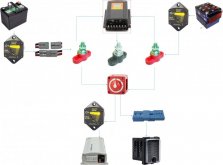Hey hey all, so after some planning, searching, and figuring I'm close to knowing what I want but would like to run it by some topic knowledgeable folk.
I am on a budget as I'm unemployed and working from limited savings, but am willing to spend where warranted.
Any input, criticisms, or suggestions are welcome, provided they are pertaining to the topic and not life choices...
For the battery, I decided to go with LiFePO4 using this 4 cell prismatic battery and this Daly BMS.
The same company also offers the cells with a BMS, but if the BMS above is fine, it's $50 cheaper.
I'm looking at a Renogy DCC50S to charge from alternator or solar, and after reading the thread on it here will be adding a relay to disconnect solar with the engine running, and disconnect starter battery with engine off to avoid a drained starter battery.
The solar panel may not be added until later pending on how finances are looking when I get to that point, but am looking at a 175w or 200w panel from Renogy.
For an inverter I'm looking at this 1500W PSW mainly having a wired remote on/off over BT.
I'd also like to be able to switch this from house or starter battery, mainly so if the engine is running it will run off alternator and not house battery.
Plus then various other power rails, distribution blocks, fuses, breakers, and 12v/USB outlets.
That's all I got for now, plus I've already droned on long enough for one post...
Thanks for looking!
I am on a budget as I'm unemployed and working from limited savings, but am willing to spend where warranted.
Any input, criticisms, or suggestions are welcome, provided they are pertaining to the topic and not life choices...
For the battery, I decided to go with LiFePO4 using this 4 cell prismatic battery and this Daly BMS.
The same company also offers the cells with a BMS, but if the BMS above is fine, it's $50 cheaper.
I'm looking at a Renogy DCC50S to charge from alternator or solar, and after reading the thread on it here will be adding a relay to disconnect solar with the engine running, and disconnect starter battery with engine off to avoid a drained starter battery.
The solar panel may not be added until later pending on how finances are looking when I get to that point, but am looking at a 175w or 200w panel from Renogy.
For an inverter I'm looking at this 1500W PSW mainly having a wired remote on/off over BT.
I'd also like to be able to switch this from house or starter battery, mainly so if the engine is running it will run off alternator and not house battery.
Plus then various other power rails, distribution blocks, fuses, breakers, and 12v/USB outlets.
That's all I got for now, plus I've already droned on long enough for one post...
Thanks for looking!
Last edited:






